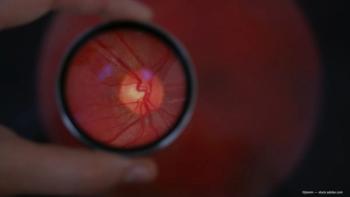
THR-687 protective against diabetic macular edema hallmarks in diabetic rats
THR-687 is currently being evaluated in a phase 2 clinical trial in patients with DME. The first data from the dose-optimization study is expected to be released in the first half of 2022.
Tine Van Bergen, PhD, reported the preclinical data from a study of THR-687 (Oxurion NV), a selective RGD integrin antagonist, for treating diabetic macular edema (DME). The results showed that THR-687 provides protection against retinal vascular permeability, inflammation, and reactive gliosis in a diabetic rat model. Dr. Van Bergen is a senior scientist with Oxurion NV.
RGD-binding integrins modulate numerous biological processes including cell differentiation, adhesion, shape, migration, motility, invasion, proliferation, and survival. Under pathological conditions, integrins may be aberrantly activated. In the eye, integrins have been shown to play an important role vascular leakage, inflammation, angiogenesis, and gliosis. Consequently, integrins have emerged as promising targets for therapeutics development.
Dr. Van Bergen and co-workers investigated the potential of THR-687 in the streptozotocin (STZ)-induced diabetic rat model to determine the effects on DME-related hallmarks. They tested 3 intravitreally injected doses (6.7, 16.7, or 75 µg/eye) of THR-687 or vehicle (control) in both eyes of the animals at intervals of 1 week.
The investigators reported, “THR-687 reduced the diabetes-induced increases in retinal permeability versus vehicle in a dose-dependent manner. Furthermore, all doses of THR-687 also significantly reduced the number of inflammatory cells compared to vehicle. The highest dose of THR-687 reduced the diabetes-induced activation of Müller cells.”
Based on the results, they concluded that THR-687 inhibits vascular permeability, inflammation, and gliosis in the diabetic is rat model. In addition, because of its multifaceted mechanism of action, THR-687 may have the potential for a broader biologic effect compared to anti-VEGF therapy.
THR-687 is currently in Phase 2 clinical trial (INTEGRAL - NCT05063734), which consists of a two-part study. Part A aims to select the dose level after multiple injections, while Part B will evaluate the efficacy and safety of the selected THR-687 dose versus aflibercept in treatment-naïve and previously treated DME patients. The data of Part A study is expected to be released within this quarter.
Newsletter
Don’t miss out—get Ophthalmology Times updates on the latest clinical advancements and expert interviews, straight to your inbox.








































